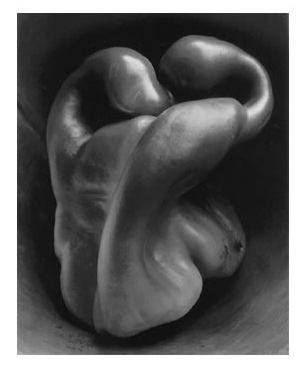The thing that sets photography apart from the other arts, says Weston, is that it is an instantaneous process. All other forms of art can be changed and altered but the photographic process cannot be 'drawn out'. Not true I feel now the use of long exposures is more common again.
Once the image has been instantaneously captured, he maintains, there are certain qualities that separate it from other forms of art: the exceptional clarity and detail in the image and the unbroken sequence of subtle gradations from black to white. Of course, the image only has great clarity if it is sharp and it may not be so, either by accident or design; also colour is the more common form of photography in the 21st century. Weston says that rather than being made up of lines as in a painting, but is made up of tiny particles (pointillists?). He also says that photographic images have the qualities of lucidity and brilliance of tone and only printing on smooth gloss papers and never on dull-surface papers.
Weston then goes on to discuss visualization. As the process is instantaneous and the nature of the image is unable to survive manipulation as done by the painterly exponents then "it is obvious that the finished print must be created in full before the film is exposed". In other words it must be built in the photographers mind or previsualized to use a word coined by Ansel Adams, also a member of Group F64. If this didn't happen the result would either be a failure or a happy accident, but not successful by design. The photographer had to learn to see photographically. He says that in the photo-painters' opinion photography could never be art. Weston, however, maintains that the end result can be controlled in many ways: varying camera position, camera angle, lens focal length, changing the light or using a filter. Then in the darkroom there is the length of exposure, type of developer or type of emulsion. He goes on to say that as there are so many ways to control the resultant image many never master the medium. A large number of photographer continually search for the latest piece of equipment or are constantly changing it for new. He maintains that they would be better off sticking to a very simple set up and mastering it.
Weston suggests that there is no distinct line between what constitutes a suitable subject for photography and for the other arts but he argues that the painter-photographers chose subjects that would never have been suitable for the medium. He tells us that, while the rules of composition are important they should not be a straight-jacket. "Following rules of composition can only lead to tedious repetition of pictorial cliches" and goes on to say that composition cannot be taught and is only the strongest way of seeing the subject and is a matter of personal preference.
 |
| Image 1 |
_large.jpg) |
| Image 2 |
I surprised myself when I read this essay. When I selected it, I expected to agree totally with what Weston said; and I do agree with a lot. I have always been a great fan of Ansel Adams' work and my photographic background is wildlife and landscape which lend themselves to this ideal. Although working digitally and in colour, I have always aimed for crisp sharp images and have discarded any that were not so. It is only recently that I have begun to change my opinion and style by reading about and experimenting with ultra long exposure photography and Intentional Camera Movement Photography and studying the work of people who specialise in these genres. I do feel that there is a place for both and indeed practice both 'modernist' and pictorialist' genres. I feel that Weston is being far too one sided in his argument and the essay has been written at a time when Group f64 were trying set themselves up in opposition to the Pictorialists; it is, perhaps, a dig at them.
Perhaps the Pictorialists are back; if they have ever gone away.
 |
| An example of one of my own Pictorialist images using differential focus. |
1. Weston, E. (1930) Pepper, [Black and White Photograph] [online image] Weston family website. Available from: http://www.edward-weston.com/ [Accessed 20.04.14]
2. Weston, E.(1930) Cypress, Point Lobos, [Black and White Photograph] [online image] Weston family website. Available from: http://www.edward-weston.com/edward_weston_point_lobos_2.htm [Accessed 20.04.14]
Check the source DigitalEssay.net This site is really helped me out gave me relief from essay headaches. Good luck!
ReplyDelete